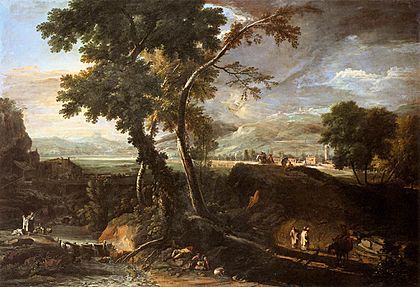Marco Ricci facts for kids
Marco Ricci (born June 6, 1676 – died January 21, 1730) was an Italian painter from the Baroque period. He was famous for his beautiful landscape paintings. He also created amazing stage designs for operas and worked with other artists.
Contents
Marco's Early Art Journey
Marco Ricci was born in Belluno, Italy. He started learning art from his uncle, Sebastiano Ricci, around 1694. They likely worked together in Milan. In 1696, Marco went to Venice with his uncle. Later, he visited Rome, where he painted many pictures of buildings and scenes with correct perspective.
Around 1706 and 1707, Marco worked with his uncle on decorating a special room called the Sala d'Ercole in the Palazzo Fenzi in Florence. Marco often worked with other artists, which makes it a bit tricky to know exactly what his early style was like. However, we know he was inspired by famous painters like Claude Lorrain, Gaspard Dughet, and Salvator Rosa. He also learned from the natural way landscape painting was done in the Veneto region of Italy.
Time Painting in England
Working on Stage Designs
In late 1708, Marco Ricci traveled to England. He was encouraged to go by Charles Montagu, who was the British ambassador to Venice. On his way, Marco stopped in the Netherlands to study Dutch landscape paintings.
In England, Marco often worked with another artist named Giovanni Antonio Pellegrini. They created stage scenery for Italian operas at the Queen's Theatre in Haymarket. They painted scenes for two operas: Pyrrhus and Demetrius and Camilla. Marco and Pellegrini also painted six large mythological pictures for Burlington House.
Landscapes and Other Art
Marco Ricci went back to Venice in 1711. But he returned to England the next year with his uncle Sebastiano. They worked together on several art projects. During his time in England, Marco Ricci also painted many landscapes and capriccios (fantasy landscapes). He also created a funny painting called Opera Rehearsal.
Marco's landscape paintings can be grouped into four types:
- Mountain views or peaceful country scenes.
- Scenes of violent country storms.
- Pictures of old ruins.
- Scenes of villages or courtyards.
Many of his works were oil paintings on canvas. About half of his smaller paintings were done using tempera paint on goatskin.
Return to Venice
Later Works and Influence
Marco Ricci returned to Venice in 1716 and lived with his uncle until he passed away. In the 1720s, Marco created a huge amount of art! He painted landscapes, capriccios, and made drawings for stage designs and funny caricatures. He also worked with Sebastiano on large paintings with people in them.
From 1723, Marco Ricci started making etchings (prints from metal plates) based on his own designs. These prints showed views and landscapes with ruins and figures. He made a notable set of twenty-three prints that were similar to the style of Piranesi, another famous artist.
Important art collectors in Venice, like Consul Smith and Zanetti the Elder, bought Marco's art. Marco Ricci is seen as the artist who started a new style of Venetian landscape painting. This style quickly became popular all over the world. He died in Venice in 1730. Two of his students were Domenico and Giuseppe Valeriani.
Gallery
See also
 In Spanish: Marco Ricci para niños
In Spanish: Marco Ricci para niños





